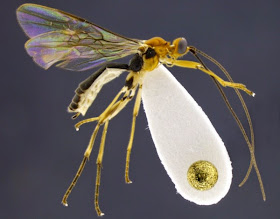The parasitic Aleiodes wasps deposit their eggs inside a
caterpillar, and when the babies hatch, they desiccate them from the
inside—which is “pretty unusual” for wasps, said study co-author Scott Shaw, an entomologist at the University of Wyoming in Laramie. (Also see “Nearly 200 New Species of Parasitic Wasps Discovered in Costa Rica.”)
Shaw and a group of students from the University of Wyoming
identified the new wasp species during recent expeditions to northern
Ecuador’s Yanayacu Biological Station.
For 16 of these 24 wasps, the team identified the caterpillar species upon which they prey, according to the study, published April 28 in the journal Zookeys
Mummy Dearest
Found worldwide, wasps in the genus Aleiodes are obligate parasites, meaning they rely on another species to complete their life cycle.
Once a female Aleiodes wasp finds a caterpillar host,
she injects an egg into its body. At first, the caterpillar doesn’t even
seem to notice. As the egg develops into a larva, however, it consumes
the caterpillar from the inside out, making it shrink and become
discolored. Further development inside the caterpillar hardens its
surface and causes it to shrivel, creating the mummy-like appearance.
The larvae pupates inside the husk of its host, eventually cutting a hole in the back of the mummy, from which it emerges as an adult wasp.
The whole process takes several months from the initial injection of the egg to the final emergence of the adult.
Source: Here


No comments:
Post a Comment